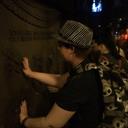Which is the correct name attributed to the figurine shown in the picture?
A nutcracker is the correct name for the figurine shown in the picture. As early as the 15th century, figurative nutcrackers were a good luck symbol in Germany with folktale accounts that a puppet-maker won a nutcracker challenge by creating a doll with a mouth for a lever to crack the nuts. Wood carvings of a soldier, knight, king, or other professions are typically portrayed.
Wooden figurines small and large, portray a person with a large mouth which the operator opens by lifting a lever in the back of the figurine. Originally one could insert a nut in the big-toothed mouth, then press down and crack the nut.
Today, modern nutcrackers serve as decorations, mainly seen at Christmas time, a season when they are readily displayed in houses, commercial places of business and in front of building entrances as shown in this picture.
The ballet ‘The Nutcracker”, derives its name from this festive holiday decoration. This ballet was first performed in 1892 in two-acts. It is a Russian fairy tale with a musical score by Pyotr Ilyich Tchaikovsky (Opus 71), a Russian composer of the romantic period of music. He lived from 1840 till 1893.
A nutcracker is also a tool designed to open nuts by cracking their shells. By the 14th century in Europe, nutcrackers as a tool, were documented in England, including in ‘Canterbury Tales, a Middle English collection of 24 stories by Geoffrey Chaucer (1340-1400).
More Info:
en.wikipedia.org







